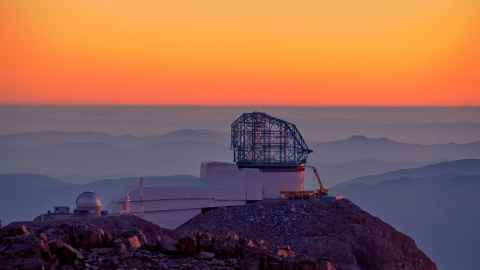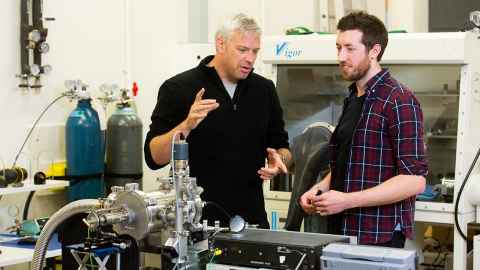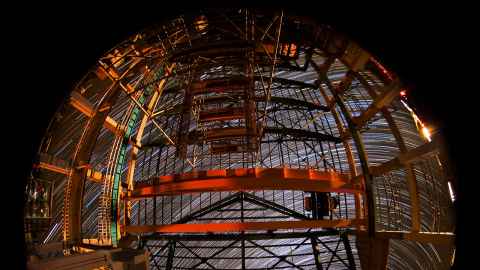Stars on film
9 December 2019
The science of star gazing will be taken to an entirely new level in 2022 when a next-generation telescope fitted with the world’s largest digital camera starts to capture what’s been described as the first motion picture of the Universe.

Currently under construction in Chile, the $USD626 million Large Synoptic Survey Telescope (LSST) is a joint venture between the United States Department of Energy and National Science Foundation, but is being supported by scientific communities from many countries, including New Zealand.
Conceived in the late 1990s, the LSST was originally called the Dark Matter Telescope because of the desire to explain the dark matter that makes up about 85 percent of the mass of the Universe. Since then, the project has evolved to address some of the most pressing questions about the structure and evolution of the Universe based on four key science pillars:
- Understanding the nature of dark matter and dark energy
- Detecting hazardous asteroids and cataloguing the remote solar system
- The formation and structure of the Milky Way
- Exploring the transient sky
Programming surveys of the night sky
While most telescopes make observations more or less on demand, Dr Nick Rattenbury from the Department of Physics says the LSST is completely different because it will be programmed – with a certain degree of flexibility – in advance for a ten-year survey over half the night sky.
“They’re going to set it all up to start off with and say we’re going to use the telescope this way, hit go, and sit back and let the data flow.”
Which is why Nick has engaged PhD student Martin Donachie to conduct simulations, which are also being conducted by scientific communities worldwide, to determine how the telescope might satisfy potentially conflicting research needs as it trawls the sky every two or three nights.
Partially funded by Nick’s Royal Society of New Zealand Rutherford Discovery Fellowship, the simulations will form the basis of proposals submitted by several international collaborations to the LSST Science Advisory Committee which is expected to announce an initial observing strategy in early 2021 that will be optimised to address the four key science pillars.
“It’s a giant optimisation problem,” says Martin. “It’s about trying to collaborate and find common ground to advocate for the observations that are best for your science, without trying to kill anyone else’s science.”

Detecting dark matter
The specific focus of Martin’s research is on exploring what’s known as the ‘transient sky’ using a technique called microlensing – an astronomical effect predicted by Einstein’s General Theory of Relativity – in which matter bends the space around it and creates a ‘lens’ that distorts and magnifies distant objects. Crucially, the lens does not need to emit any light in order for it to be detected, which makes microlensing ideally suited to the detection of faint or dark objects.
Microlensing is the only technique sensitive enough to detect low-mass planets orbiting at large distances from their host star. But what gets astrophysicists like Nick out of bed in the morning is the search for black holes – and dark matter. “We’ve got to come up with some kind of way of explaining a large fraction of the mass of this Universe, which we can’t see.”
By regularly monitoring the entire Milky Way, Martin says the LSST will find many more events that are currently going undetected. “This, in turn, will tell us about the mass distribution across the galaxy, which will have implications for galaxy formation, planetary theory and dark matter science by revealing the presence of black holes and extrasolar planets within our galaxy.”
Dark matter kicked off the microlensing game back in the late 1980s, and Nick says the hunt is still on for some hidden component of matter or new particle which carries some mass, but which is extraordinarily hard to detect. Hopes are high that the LSST can also shed some new light on the ‘dark energy’ that is causing the Universe to expand at an ever-faster rate – and tear itself apart.
“These two components of the Universe account for an embarrassing amount of mass and energy in the Universe, which we simply do not understand. So that’s why we build these sorts of things.”
Exploring theories about the expansion of the Universe
Described as potentially one of the greatest scientific experiments in human history, the LSST is expected to observe 20 billion galaxies, 20 billion stars and discover hundreds of thousands of Near-Earth Objects during its ten-year mission. The images produced will be deep enough to detect the faintest and most distant galaxies, and Martin says, “We will be able to see how stars and galaxies change over that time in exquisite detail, which will reveal new insights in fundamental areas of physics and astronomy."
It is also expected to test our fundamental understanding of the Universe. Whereas the first theories about the accelerating expansion of the Universe were based on the discovery of around 40 supernovae in the late 1990s, Martin says the LSST will find ten times that many in its first night and will likely result in many theories having to be refined or dumped. “Every conceivable area of astronomy is going to be impacted and benefited by the project,” he says.
The project will generate an estimated ten million alerts every night and, as Nick puts it, “the LSST is going to eat everybody’s lunch in terms of how much data and how much sky it observes, it’s just extraordinary”.

Discovering extrasolar planets and extraterrestrial life
The challenge for scientists like Martin will be to find the interesting events hidden in the avalanche of data. Which is why the scientific community will conduct follow-up observations using other telescopes, including the University of Canterbury Mt John Observatory near Lake Tekapo (part of the Microlensing Observations in Astrophysics (MOA) collaboration with Japan and the US). MOA has been staring at the centre of our galaxy for the past two decades and observes hundreds of events per year. When there are millions of stars, you need to monitor all of them just to see a few microlensing events. “The more stars you can see, the more chances you’ve got, it’s an odds game,” Martin says.
The MOA collaboration is currently building a second telescope in South Africa that will operate in the infrared and perform precursor observations for yet another major project called the Wide Field Infra-Red Space Telescope (WFIRST).
Operated by NASA and costing an estimated USD3.2 billion, the WFIRST space observatory is expected to launch around 2025 with the goal of precisely measuring the effects of dark energy and probing the expansion history of the Universe.
Future plans for WFIRST include a microlensing survey in tandem with LSST which Martin says is expected to detect thousands of extrasolar planets including hundreds of Earth-mass planets – considered to be one of the ultimate goals for astrophysicists because of the prospect of finding other life forms.
Indeed, one of the more exciting aspects for Nick is the prospect of discovering all sorts of planets and very low mass worlds that contain moons, like Jupiter’s Europa, that have a cold outer surface with a liquid ocean beneath which could conceivably harbour extraterrestrial life.
“If we start speculating that life could exist in a sub-surface ocean, then discovering these sorts of worlds adds more information to how many worlds are out there where life could take hold – that’s part of the excitement for WFIRST.”
LSST | www.lsst.org
inSCight
This article appears in the December 2019 edition of inSCight, the print magazine for Faculty of Science alumni. View more articles from inSCight.
Contact inSCight.